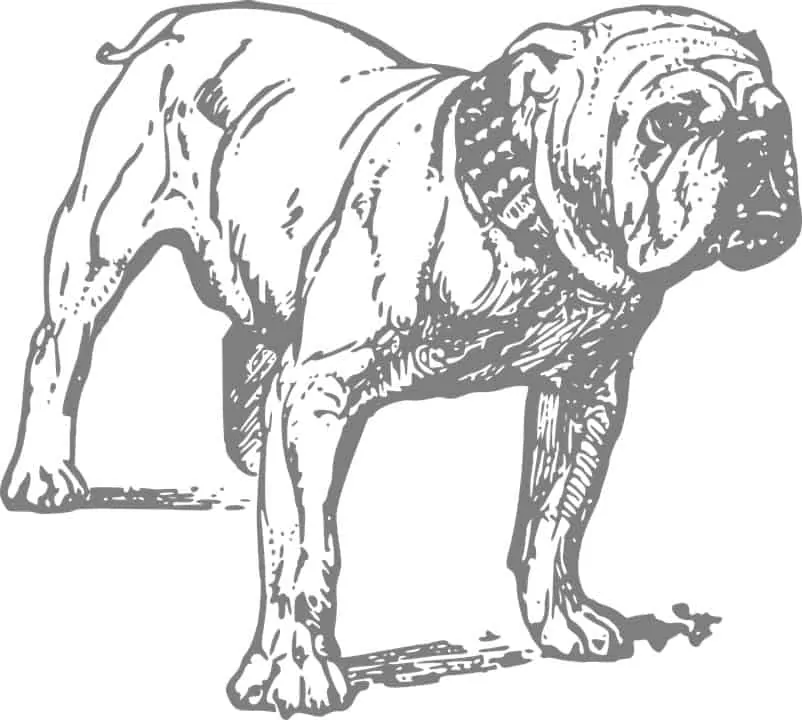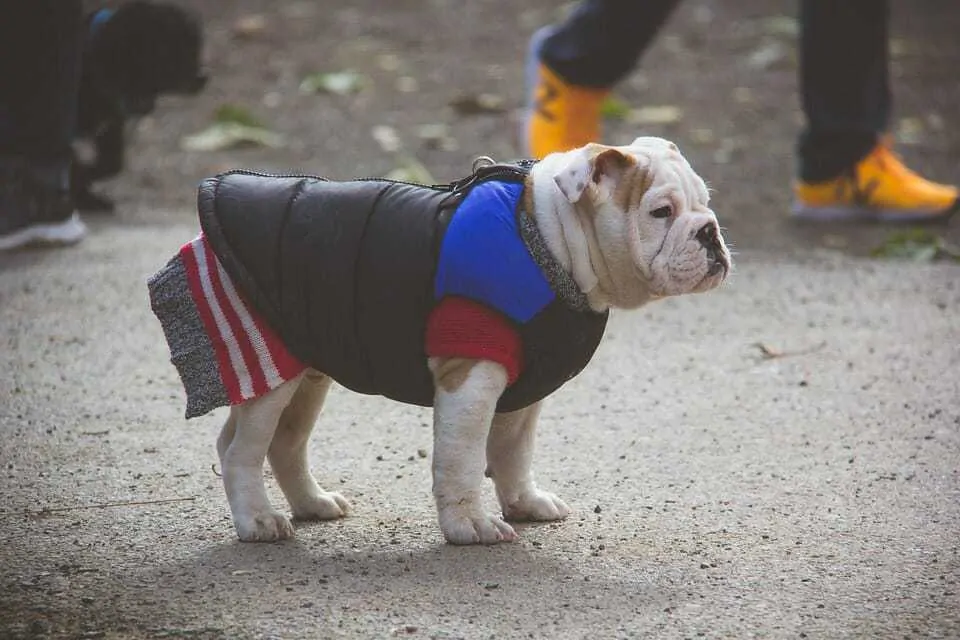The upturned expression, stubby legs, and oversized head make the English bulldog one of the most recognizable breeds in the world. The fact that they are extremely popular helps a little, too. With looks like that and a personality that makes them a good fit for suburban families, apartment dwellers, and everyone in between, it’s not surprising that these dogs have won the hearts of millions.
But there is more to the bulldog’s story than just a ridiculous appearance and a calm disposition. Keep reading to find out if the full EB package is truly a good fit for your lifestyle.
Contents
General Characteristics of the English Bulldog
- Other names: Brittish Bulldog
- Height: Under 16 inches
- Weight: 40 to 50 pounds
- Lifespan: 8 to 10 years
- Origin: England
- Colors: Piebald brindle, fawn, red, or solid brindle, white, fawn, or red
- Activity level: Low to moderate
- Grooming needs: Low
- Best suited for: Novice owners, families, apartment living
There is hardly a more recognizable breed out there than the famous English bulldog. This adorable face is just one of the reasons these dogs are so popular across the world.
The History of the English Bulldog
Like all breeds that share the bulldog name, the English bully’s history is seeded in violence. Throughout Europe, large-bodied dogs were often utilized by farmers to help restrain bulls. These powerful and athletic dogs would latch onto the bull’s nose and hold it still while their owner secured the animal with a rope.
In England, this practice eventually morphed into the gambling sport of bullbaiting. Soon, owners were working to breed the perfect bull baiter–a dog thick with muscle, an upturned nose to allow it to breathe while holding tight to a bull, and wrinkly facial rolls to move blood away from the nose and eyes.
The first mention of these “bulldogs” can be traced back to the early 1600s. They continued to be refined and gain popularity through the next two hundred years until the passing of the Cruelty to Animals Act in 1835. With bullbaiting and dogfighting now banned in England, these specialized hounds were out of a job.
Over the next hundred years, the original bulldogs were transformed into multiple bulldog breeds including the Frenchie, American bulldog, and Staffordshire bull terrier. Those who adored the original look of the bull-baiting dogs worked to transform them from a ferocious beast fighter into a calm and affectionate companion dog that would become the English bulldog.
The original EB was taller and more athletic than today’s bully. Unfortunately, this downsizing has come with a number of health issues, making this one of the most unhealthy breeds out there.
In addition to changes in temperament, the breed also experienced drastic changes in physical appearance. The slightly upturned muzzle was exaggerated until the lower mandible stuck out beyond the lips of the upper. The legs grew shorter and the breed became much more compact and less athletic.
Today’s EB sees both the benefits and pitfalls of this intentional selective breeding. They have sweet personalities that don’t at all reflect their original purpose. But at the cost of physical changes that affect their ability to run, breathe, and even reproduce.
The Temperament of the English Bulldog
If you were to take the EBs personality in a vacuum, this dog would be close to perfect. They are calm, gentle, and tolerant. They enjoy snuggling down on your lap during your favorite movie almost as much as clowning around for your entertainment.
They can be somehow both stoic and animated at the same time. They make noises like no other breed and live to be the focus of everyone’s attention. Combine these tendencies with prolonged adolescents, and you can pretty much guarantee your EB will be the light of your life.
Beyond their comical personalities, these dogs have low to moderate energy levels, which makes them perfect for apartment living. With a daily walk and plenty of human attention, they will thrive. While they do love their humans, they are much more tolerant of being left alone for short periods of time than their French cousins.
They can be over-independent in some situations and often find themselves in trouble because of it. They’ll follow their curiosity wherever it takes them, so keep an eye your EB anytime they are off-leash or in a new situation.
The English bully’s goofy personality and a knack for getting into comical situations make them entertaining pets for families and individuals alike.
These dogs can make good watchdogs, and do typically alert if someone unfamiliar comes knocking. Though, they are typically accepting of strangers and aren’t likely to back up their bark with any kind of aggression.
While they may possess the type of personality of a dog you would want to bring everywhere, their physical build can make car, air, and even foot travel difficult. And they absolutely need a home indoors where the temperature can be controlled when it is too hot or cold outside.
Health Issues Common to the English Bulldog Breed
Outside of that vacuum that encompasses their perfect personality, the EB has a number of physical and health issues that can make these dogs expensive and heartbreaking to own.
Because of their compact build, these dogs can suffer from a host of joint, respiratory, and skin issues. Here are some of the more common health problems seen in this breed:
- Skin allergies
- Eczema
- Acne
- Fold dermatitis
- Cherry eye
- Idiopathic head tremors
- Hip dysplasia
- Elbow dysplasia
- Arthritis
- Degenerative spine disease
- Respiratory problems
- Heart disease
- Cancer
Despite all there is to love about the English bully, their health problems and shortened lifespan are enough of a reason to take pause before committing to this breed. You should be confident that you will have the money and resources to take care of an aging bully before ever purchasing one.
Because of their squished face and tendency to have respiratory problems, EBs do not do well in hot environments. Dogs rely on panting to keep themselves cool in hot weather. As air moves in and out of the mouth and nasal cavity, it cools the blood moving through these soft tissues.
Unfortunately for the English bully, the shape and size of their mouth and nasal cavity renders panting practically useless. This means they can overheat quickly. Without human intervention, an overheating bully can suffer from brain damage and even death.
For this reason, EBs should never be left in a parked car, even if it is only warm, not hot out. They also do not do well flying the cargo hold or outside in hot weather. Even in temperate weather, an EB can become overheated if they overexert themselves. Walks should be kept short, especially in the summer. And always keep an eye on your dog and take a break if they begin panting hard or are having trouble keeping up.
While their mouths may be shrunken, their heads are enlarged. This is problematic for pregnant females who often struggle to pass puppies through the birth canal. For this reason, many EBs are born through scheduled c-section.
<iframe width=”560″ height=”315″ src=”https://www.youtube.com/embed/LWv8jPRP5dg” frameborder=”0″ allow=”accelerometer; autoplay; encrypted-media; gyroscope; picture-in-picture” allowfullscreen></iframe>
Learn more about EBs in this episode of Dogs101.
In addition to issues caused by their physical build, EBs also suffer from higher cancer rates than any other dog breed. Despite being a medium-sized breed, their lifespans are similar to breeds like the great Dane, with a remarkable number dying before the age of 7.
If you are considering a purebred EB, you should absolutely do your homework when looking for a breeder. Never buy a bully from a pet store or online. Any breeder who is willing to ship you an EB puppy is likely to be a less ethical breeder and one to avoid. Responsible breeders will always let you see the area litters are kept, introduce you to the parents if on-site, have full health checks done on their dogs, and keep health records for the line.
Given the popularity of these dogs, there are many out there in need of good homes. Instead of purchasing a puppy, consider adopting one of these homeless EBs. These dogs tend to be cheaper, have had health screenings so you know what you are getting, and you’ll be saving the life of one of these wonderful clowns.
Do English Bulldogs Do Well With Children and Other Pets?
The calm and unflappable personality of an EB make them great choices for homes with children. And, while they are large and strong enough to tolerate horseplay, they aren’t as likely to knock down or injure a child as other family-friendly large breeds.
English bullies typically get along very well with other animals, though, older dogs may not enjoy roughhousing with their doggy playmates the way they once did.
Of course, every dog is an individual and you should always supervise dogs and children together. Make sure to teach your child from an early age how to interact with a dog appropriately and respectfully. Even if your bully is tolerant enough to let your toddler yank on their ears, that doesn’t mean the neighbor’s dog will be so forgiving.
EBs also tend to get along well with other pets.
They typically enjoy the company of other dogs, though some can be less than enthusiastic about sharing their house. This is especially true of older EBs who may be suffering from painful joints and other health conditions. Socializing your EB puppy with a variety of other dogs and animals is a great way to ensure that they will be accepting of new housemates later on.
In addition to dogs, EBs usually do well with other pets such as cats and birds. They may try to play with their feline siblings but aren’t typically aggressive. Again, socialization in this area early on will help establish a tolerant and gentle adult dog.
What to Consider Before Bringing Home an English Bulldog
Think you have what it takes to provide a safe and happy lifetime home for an EB? Here are a few more things to consider before committing to this breed.
The EB is a curious breed. This combined with their independence can get them into trouble. You’ll have to take steps to protect your English bully against dangerous situations like open water, toxic foods, and even steep stairs.
Activity Level
Despite their propensity for lounging, EBs do require some activity each day, with younger dogs needing even more than that. If you live in an area that has hot summers, you’ll need to consider alternative activities to the standard outdoor walk during this time of year. Well air-conditioned doggy daycares are a great choice. So are puzzle toys and other indoor activities.
Also, consider how often you’ll be able to be home with your dog. While they may not require a ton of exercise, they do enjoy their people. And since they can’t accompany you everywhere, there are going to be times when they need to be home alone. You may need to look into a dog walker or pet sitter familiar with EBs unique needs for those longer workdays.
Trainability
While EBs aren’t known for their intelligence, they aren’t dull either. They are generally trainable, though they can be stubborn. Finding the right motivation is key, especially for older dogs. Treats usually work well for this breed, just be careful not to overdo it with the extra calories.
Getting your puppy into a training class early is recommended. This will also give you extra opportunities to socialize your EB with other people and dogs.
Grooming
With a short coat, you might think grooming the EB would be a breeze, but you’d only be half right. The occasional bath and weekly brushing is plenty to maintain the coat and control shedding, but most of your grooming work will be concentrated on those adorable skin folds. EBs are prone to infection and dermatitis in their wrinkles. You will need to wipe these areas out daily with peroxide or another cleanser.
In general, EBs are prone to a host of skin problems and allergies. Special shampoos, ointments, and other topical treatments may be necessary and can even become a daily routine. Make sure you are committed to this depth of care before even considering the breed.
In addition to not doing well in hot climates, English bullies are also susceptible to the cold. Their thin, short coat won’t provide enough insulation for frigid weather, so plan on buying some doggy coats if you live in a colder climate.
Nutrition
Most EBs are good eaters and will do well on a quality diet. Keep an eye on their weight and make sure to control their calorie intake to avoid stressing their already stressed joints. Some dogs may benefit from a weight maintenance food. Dogs with food allergies will require limited ingredient diets which tend to cost more than normal food. Supplements for coat health can also come in handy.
Cost
Expect to pay at least $1500 for a purebred EB. Anything less is likely to be from a less responsible breeder and more prone to health issues. Adopting a bully generally costs around $300.
In addition to the upfront costs, expect to pay more for vet bills and health treatments than with your average breed.
>>>Find out how much it actually costs to own a dog.
10 Fun Facts About the English Bulldog
Now that you know a little more about what it takes to care for and own an English bully, it’s time to learn a little more about the breed. Here are some fun facts about EBs.
- The Bulldog Club in England is the oldest single breed club.
- The EB is the official mascot of the US Marine Corps.
- The original bulldogs were said to be impervious to pain and would continue competing even after suffering severe injuries in the bullbaiting ring.
The most common EB colors are white, brindle, and various shades with large areas of white. But these dogs can come in a wide array of colors including this very beautiful blue and tan combination.
- Despite their love of their people, English bullies tend to be independent when solving problems.
- The EB is the national breed of England.
- Because of the size of their head and stubby legs, most EBs can’t swim and should be kept away from pools.
- Close to 40 US universities claim the EB as their mascot, including Yale.
- A skateboarding EB named Otto has become a Youtube sensation and a Guinness World Record holder.
- English bulldogs have been in the top 5 most popular dogs in the US for years.
- EBs are famous for their flatulence, snoring, and drooling.
Before You Go
Wondering if you have what it takes to own an English bulldog? Here are some more Ultimate Breed Guides to browse through while you decide.

Jen Jones is a professional dog trainer and behavior specialist with more than 25 years of experience. As the founder of ‘Your Dog Advisor’ and the ‘Canine Connection’ rehabilitation center, she applies a holistic, empathetic approach, aiming to address root causes rather than merely treating symptoms.
Well known for her intuitive and compassionate approach, Jen adopts scientifically-proven, reward-based methods, encouraging positive reinforcement over punishment. Jen specializes in obedience training, behavior modification, and puppy socialization. Her innovative methods, particularly in addressing anxiety and aggression issues, have been widely recognized. Jen has worked with many of the world’s leading dog behaviorists and in her free time volunteers with local animal shelters and rescue groups.








